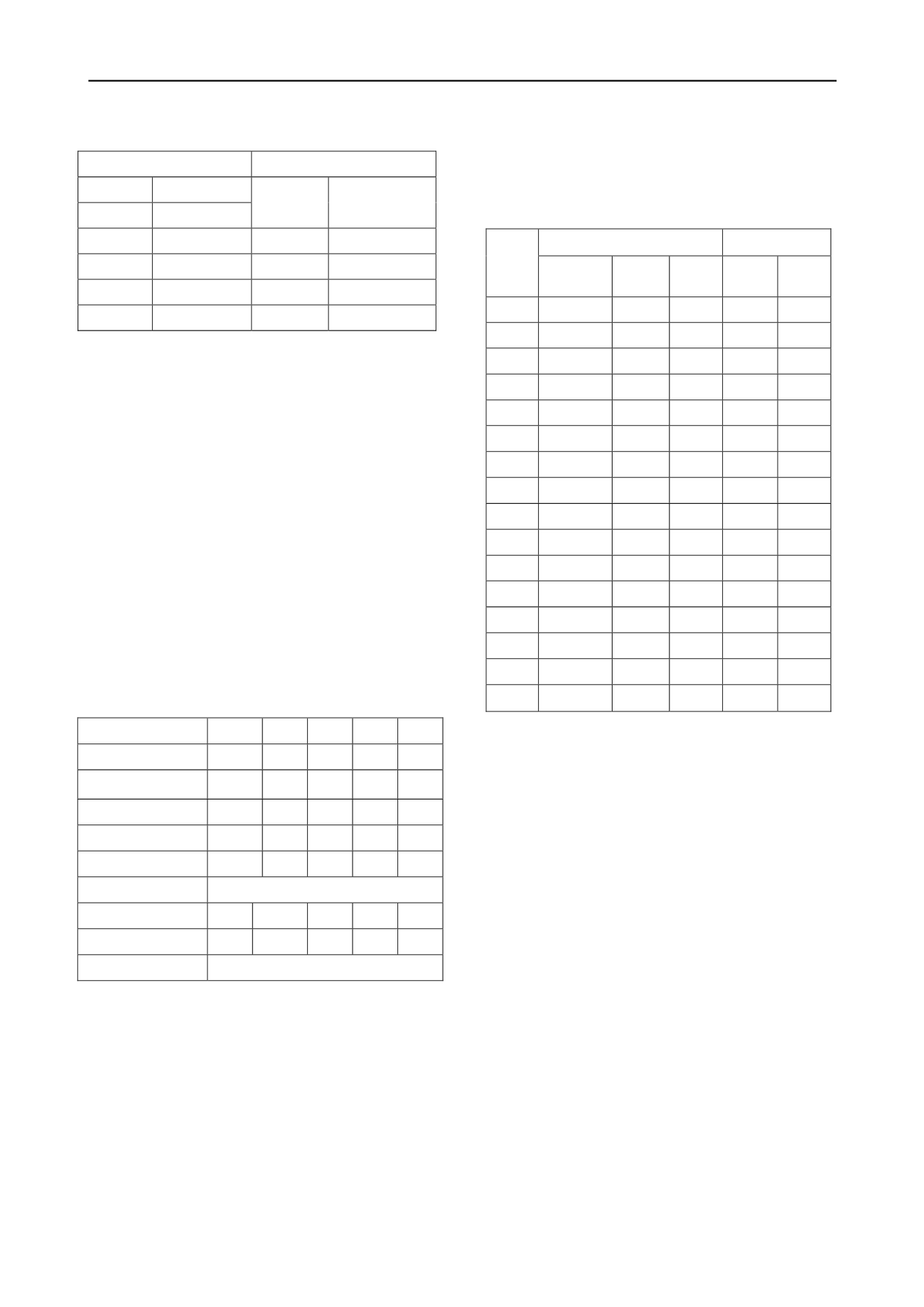
2288
Proceedings of the 18
th
International Conference on Soil Mechanics and Geotechnical Engineering, Paris 2013
Table 2. Ground anchor assessment classifications
Individual capacity assessment
Total capacity assessment
β
class
0
X. Defective
α
class
β�30
A. Worst
α�30
A. Worst
30<β�55
B. Unacceptable 30<α�55
B. Unacceptable
55<β�80
C. Acceptable
55<α�80
C. Acceptable
80<β
D. Normal
80<α
D. Normal
Ground anchor inspection items will be measured with
apparatus, which is the best and most direct way to understand
the existing conditions of the anchors and remaining bearing
capacities. These values usually will be referred to while
performing sloping reinforcing analysis. Of course the anchor
capacity cannot and should not base solely on the lift-off test
result. There are other factors such as ground condition below
the anchors for possible cave-ins, steel tendon or anchor head
surface appeared rusted and cracked. When a sloped terrain of
which 1/3 of the ground anchors inspected has reach over 90%
rusted surface under the examination of endoscopy, but the lift-
off test revealed remaining capacity falls into the range
0.8Tw<Tr�1.2Tw. Such conditions should be cross referenced
with other data like field observations and inspections and
evaluate in totality whether the slope has a tendency to slide.
This article brings forth various anchor evaluations by which
will address the possible different scenarios that might be
overlooked otherwise. In order to validate
the
practicality of
Table 1, this article takes 16 slopes and conduct a simulating
calculation for them. The results are as shown in
Table 3 and 4
.
The results and classifications are consistent, thus prove the
validity of this assessment procedure and its practicality.
Table 3. Case study of Single ground anchor capacity assessment
No. of anchors
S4-1
S4-2
S4-3
S4-4
S4-5
Exterior inspection
7.5
7.5
7.5
7.5
7.5
Anchor head
assembly inspection
11.25
11.25 11.25 11.25 11.25
Endoscopy inspection
22.5
30
22.5
30
30
Lift-off test
33.75
45
33.75 45
45
β
75.0
93.8
75.0
93.8
93.8
α
86.3
Class of lift-off test
C
D
C
D
D
Class of β
C
D
C
D
D
Class of α
D
5 CONCLUSION
Based on collected statistical data, 90% ground anchor failure
are resulted at the anchor head proximity and free section part
of the steel tendon. This article had gathered data which
initially showed free section was not completely filled with
concrete for nearly 85% of the ground anchors being examined,
therefore making it the most prevalent shortcoming. To avoid
anchors becoming defective which leads to disaster, anti-
corrosive remedy should be done promptly.
This article only took 16 areas of sloping terrain to gather
data on ground anchors for inspection and assessment as
explained previously. This evaluation procedure demonstrates
that the four categories assessment: inspecting the exterior
aspect of the anchor, the anchor head examination, endoscopy
inspection and lift-off tests is a logical process in finding
shortcomings. In the future it is bound to have additional data
available added to and revised upon, and would become a
valuable systematic way for the engineering industry to adopt
widely across.
Table 4. Case study of anchored slope capacity assessment
lift-off test
Total capacity
Slope
No.
Amounts
Tr(%)
Class
Scorin
g
Class
S1
6
88.2
D
83.9
D
S2
5
77.8
C
55.3
C
S3
6
35.6
B
38.9
B
S4
5
88.2
D
86.3
D
S5
5
65.5
C
77.2
C
S6
4
35.6
B
54.2
B
S7
3
52.9
C
60.2
C
S8
3
70.2
C
63.6
C
S9
4
43.3
B
62.9
C
S10
3
85.1
D
87.9
D
S11
3
108.6
D
74.7
C
S12
8
69.5
C
64.8
C
S13
7
71.2
C
61.6
C
S14
5
55.6
C
62.0
C
S15
8
53.5
C
68.4
C
S16
7
47.7
B
52.9
B
6 REFERENCES
Briaud J.L., Powers W.F. and Weatherby D.E. 1998. Should grouted
anchors should have short tendon bond length. Journal of
Geotechnical and Geoenvironmental Engineering 124(2), ASCE,
New York.
Bruce D.A. and Wolfhope J. 2007. Rock anchors for north American
dams: the national research program bibliography an database.
Institution of Civil Engineers, Ground Anchorages and Achored
Structures in Service, London, England, U.K., 481-491.
Liao H.J. and Cheng S.H. 2011. Failure cases of anchors and anchored
slopes in Taiwan", Proc. of the 5th Cross-strait Conference on
Structural and Geotechnical Engineering, Hong Kong.
Ho T.Y., Hsiao C.A. and Tsai L.S. 2011. Present situations and
improvement suggestions of existing anchors in Taiwan. Sino-
Geotechnics 130, 43-54.
Jeng C.J., Chen Y.C., Chen R., Yang P.J. and Lin Y.C. 2011.
Discussion and recommendation on performance influence of
current permanent ground anchor factors through case study. Sino-
Geotechnics 130, 19-30.
Liao J.T., Wu T.H., Chen C.W. and Lu C.H. 2011. Discussion on
Establishment of prestressed ground anchor maintenance and
management system. Sino-Geotechnics 130, 79-90.


